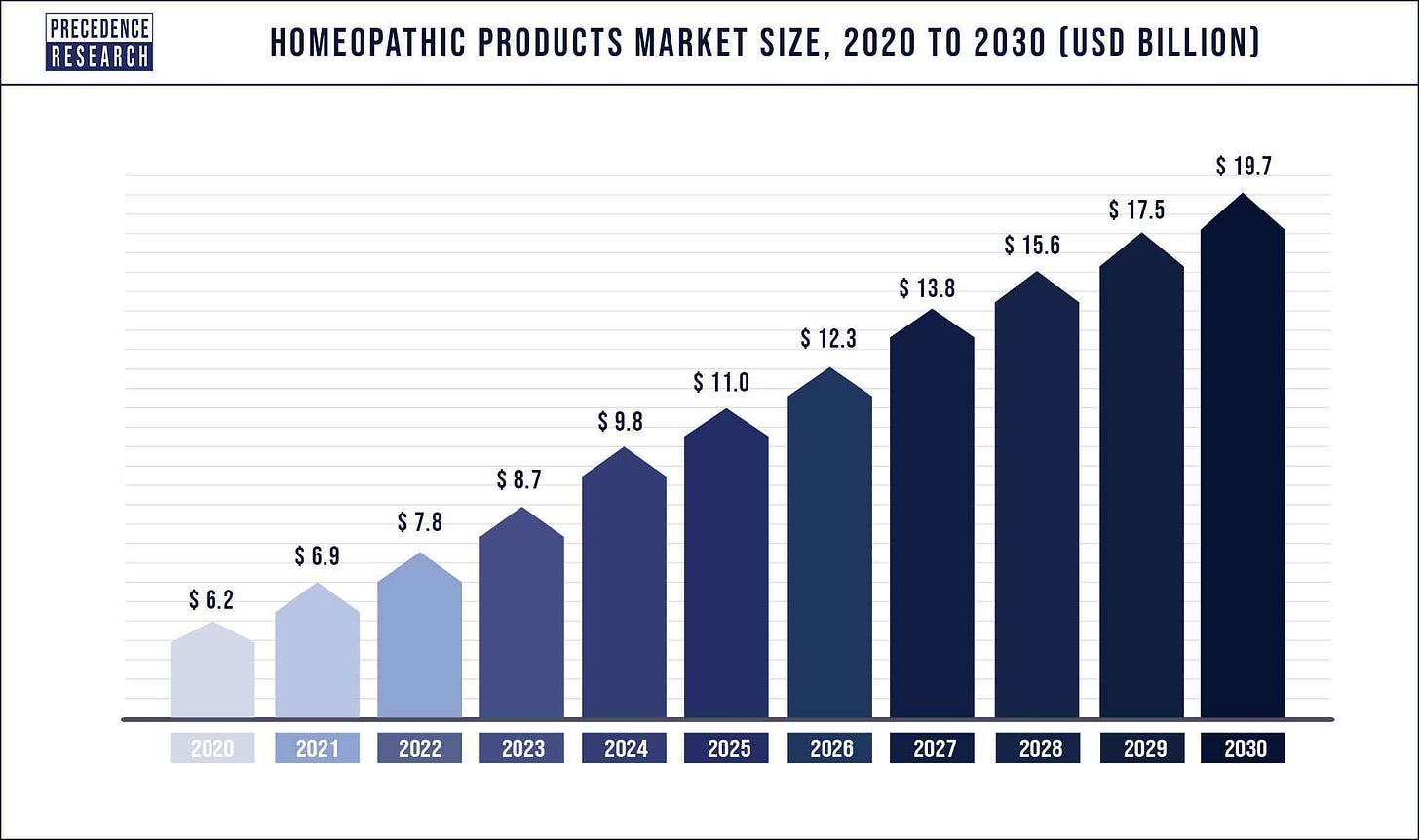Homeopathy 101
Explore the history, dilution factor, and scientific evidence behind homeopathy to make an informed decision about its efficacy.
Homeopathic products are experiencing steady growth in product sales in the USA. A market analysis reveals that:
The global homeopathic products market size was valued at US$ 6.2 billion in 2020 and is expected to reach over US$ 19.7 billion by 2030, poised to grow at a noteworthy CAGR of 12.3% from 2021 to 2030.

But, what is homeopathy, exactly? Is it an ancient form of medicine like Ayurveda or Traditional Chinese Medicine, or something more recent?
Homeopathy is based on principles of dilution factors, represented by a symbol of X, C, or D on product labels. But, what do those symbols actually mean when it comes to the concentration of the ingredients in the bottle? I address these questions and more below.
History of Homeopathy
Homeopathy was introduced as a form of medicine in the 18th Century by the German physician Samuel Hahnemann, who lived from 1755-1843. It is based on the concept of “like cures like”, in opposition to allopathy “opposite cures opposite,” or treating disease by agents that elicit effects different than those of the disease treated. Homeopathy uses materia medica of plant, animal and mineral origin in the preparation of medicaments. Examples include onion, chamomile, arnica, white arsenic, crushed whole bees, belladonna, and stinging nettle.
Materia medica is defined as the Latin term from the history of pharmacy for the body of collected knowledge about the therapeutic properties of any substance used for healing.
However, the preparation of homeopathic remedies differs greatly from those of medical herbalism traditions as the material is heavily diluted with excipients, such as water, alcohol, or sugar. Materials may be diluted to one part of the material in 10,000 to even a billion or trillion parts of the solution. Under the homeopathic system, the perceived effectiveness of the final formulation is greater when more dilute and is based on the concept of “water memory”, or “molecular memory” of the material in the solution in which it is diluted. As the proposed mechanism for homeopathy does not follow the widely accepted laws of physics, chemistry, or pharmacology, it is subject to much criticism.
Calculating the Dilution Factor of Homeopathic Remedies
There are a few different terms used to denote how dilute the homeopathic remedy is. Historically, the centesimal or C scale was used, and refers to dilutions by a factor of 100 at each stage. For example, a 2C dilution would entail diluting 1 part of the substance in 100 parts of excipient, and then 1 part of this solution to be further diluted at 1:100, yielding a final dilution of one part material in 10,000 parts excipient. Likewise, a 5C dilution would yield one part in ten billion, a 6C dilution would yield one part in one trillion, and so on. Today, other forms of notation are more common for describing the final dilution level of a homeopathic remedy. For example, one might find bottles labeled with a “D” followed by a number or an “X” preceded by a number. This refers to dilutions by decimal potency, and uses a factor of 10 at each dilution stage. For example, a homeopathic remedy labeled as D6 in dilution factor would be equal to one part material in 10-6 of excipient, or one part in a million. This would be of the same dilution factor as a remedy labeled as 6X.
Watch this video to learn how to calculate the level of dilution of homeopathic products:
What is available in stores today?
Most commercially available homeopathic products available on the market today range in dilution factors of 3X to 6X, or one part in one thousand to one part in one million. On the other hand, products with very low dilution factors (for example, 1X) may exhibit some pharmacological effect depending on the dose administered, and may also present potential for side effects or drug interactions.
Overall, however, an overwhelming number of scientific studies and clinical trials on homeopathy have revealed that its effects are no different than placebo. Despite the lack of scientific evidence, this industry is booming.
The Takeaway
There are some key points to consider with homeopathic products:
Homeopathic products are a recent innovation in the history of medicine, dating back only a couple of centuries, rather than millennia as in other forms of traditional medicine.
While these products typically incorporate materia medica (medical materials such as herbs), the concentrations are often so diluted that there is not enough active ingredient to yield any pharmacological effect.
Science has advanced quite a bit since the Hahnemann’s times, and we know today that the concept of heavily diluting a pharmacological agent does not increase its potency, but achieves the opposite: reduced activity. This is based on studies in the sciences of physics and pharmacology.
My advice? Don’t waste your money on diluted homeopathic products, and especially not with any products diluted beyond 1X. There are many other ways to access herbal products with appreciable levels of bioactive compounds present, such as in whole herbs, dietary supplements, teas, and more.
Yours in health, Dr. Quave
Cassandra L. Quave, Ph.D. is a scientist, author, speaker, podcast host, wife, mother, explorer, and professor at Emory University School of Medicine. She teaches college courses and leads a group of research scientists studying medicinal plants to find new life-saving drugs from nature. She hosts the Foodie Pharmacology podcast and writes the Nature’s Pharmacy newsletter to share the science behind natural medicines. To support her effort, consider a paid or founding subscription, with founding members receiving an autographed 1st edition hardcover copy of her book, The Plant Hunter.




